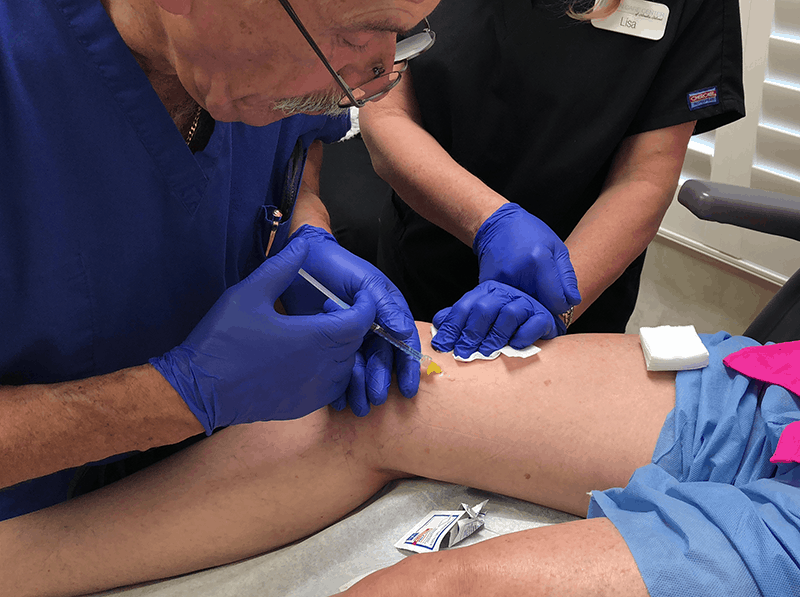What is Venous Insufficiency?
 What causes venous insufficiency?
What causes venous insufficiency?- Who is at risk for venous insufficiency?
- How is venous insufficiency diagnosed?
- What is the treatment for venous insufficiency?
- Can you reverse venous insufficiency?
Venous insufficiency is a chronic health problem when your veins fail to send blood from your limbs back toward your heart. Since every tissue in your body relies upon a constant blood flow to receive oxygen and nutrients, this can be a potentially serious condition.
Venous insufficiency occurs when the valves and vein walls are weakened or damaged. This causes the blood to pool within the veins of your legs instead of flowing back properly to the heart.
The symptoms of the disease can be as simple as leg swelling and aching, or varicose veins. When the disease is chronic (chronic venous insufficiency or CVI), you may experience damage to the skin, such as sores that don’t heal or discoloration.
What Causes Venous Insufficiency?
Venous insufficiency is caused by dilated and weakened venous walls and incompetent valves within the veins. Valve damage can occur from aging, extended sitting, or reduced mobility. All of these internal issues can manifest in swollen, aching legs and ankles, leathery looking skin on the legs, varicose veins, flaking or itching skin or ulcers on the legs.
Who is at Risk for Venous Insufficiency?
Venous insufficiency is much more common as we grow older. The natural process of aging causes the walls of our veins to weaken. As a result, people over the age of 50 are more prone to developing venous insufficiency. Women report more varicose veins and venous insufficiency, although clinicians aren’t completely certain why this is true.
People struggling with weight gain or obesity are more prone to venous insufficiency. Being overweight places more strain on your vascular system. Inactivity is a common cause of the disease. Also, a family history of this disease can predispose you to developing venous insufficiency.
How is Venous Insufficiency Diagnosed?
If you experience the signs of venous insufficiency see your doctor. You’ll receive a full physical examination and a medical history to determine if you have the disease. You may also have some imaging tests, such as a venogram or a duplex ultrasound to diagnose the problem.
A venogram is a medical procedure where your doctor will put an IV contrast dye into your veins so they will appear on an X-ray image. Alternately, a duplex ultrasound uses sound waves to test the direction and speed of the blood flow in your veins
Neither procedure is painful and they will help your doctor diagnose and develop a treatment plan to get you back to health.
What is the Treatment for Venous Insufficiency?
There are several treatments for venous insufficiency. If the disease is caught early, some simple lifestyle changes could improve your health outcomes. This could include:
- Avoiding standing or sitting too long
- Elevating your legs while sitting or lying down
- Losing weight if you are overweight
- Walking and exercising regularly
- Wearing compression stockings
In more advanced cases, you may have sores, discoloration, or flaking of the skin.
Your doctor may prescribe antibiotics to treat any skin infections and will counsel you on the best techniques for good skin hygiene. If you have a blood clot, your doctor might prescribe medications to prevent more blood clots. In some cases, the doctor may prescribe a specially medicated wrap that combines compression with a wound cover to treat any open sores.
There are also non-surgical treatments available such as:
- Sclerotherapy to collapse any small varicose or spider veins under the skin
- Endovenous thermal ablation uses a laser or high frequency radio signal to close up the target vein
- For more advanced cases, surgical treatment may be necessary. This could include:
- Vein ligation and stripping, where a vascular surgeon ties off or remotes the abnormal veins
- Ambulatory phlebectomy or a microincision is a minimally invasive procedure to remove the veins
- Vein bypass, just like a heart bypass, seeks to use a portion of a healthy vein transplanted from another part of the body to reroute blood flow around the problem area
Can you Reverse Venous Insufficiency?
While the cause of venous insufficiency cannot be reversed, you can treat the disease and make lifestyle changes that will help in the prevention of recurrence of the disease.
Your goal should be to seek a diagnosis and treatment plan and then work with your doctor to create some at-home lifestyle changes such as wearing compression stockings and elevating your legs when you’re resting.
Exercise is important to keep your blood flowing; without it, your circulatory system just doesn’t work as well. Daily exercise for about 30-minutes of even low-impact activity will help keep things moving.
Properly caring for your skin can help reduce or eliminate skin irritation. Even the simple act of staying thoroughly hydrated will help.
